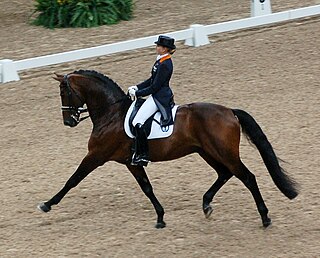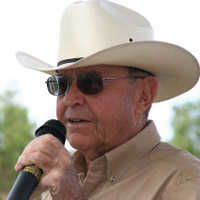
The horse is a domesticated, odd-toed, hoofed mammal. It belongs to the taxonomic family Equidae and is one of two extant subspecies of Equus ferus. The horse has evolved over the past 45 to 55 million years from a small multi-toed creature, Eohippus, into the large, single-toed animal of today. Humans began domesticating horses around 4000 BC, and their domestication is believed to have been widespread by 3000 BC. Horses in the subspecies caballus are domesticated, although some domesticated populations live in the wild as feral horses. These feral populations are not true wild horses, as this term is used to describe horses that have never been domesticated. There is an extensive, specialized vocabulary used to describe equine-related concepts, covering everything from anatomy to life stages, size, colors, markings, breeds, locomotion, and behavior.

Dressage is a form of horse riding performed in exhibition and competition, as well as an art sometimes pursued solely for the sake of mastery. As an equestrian sport defined by the International Equestrian Federation, dressage is described as "the highest expression of horse training" where "horse and rider are expected to perform from memory a series of predetermined movements."

Equestrianism, commonly known as horse riding or horseback riding, includes the disciplines of riding, driving, and vaulting. This broad description includes the use of horses for practical working purposes, transportation, recreational activities, artistic or cultural exercises, and competitive sport.

The Lipizzan or Lipizzaner, is a horse breed named for the Lipizza Stud of the Habsburg monarchy. Generally gray in color, the Lipizzan is a breed of Baroque type that is powerful, matures slowly, and noted for longevity. The breed is closely associated with the Spanish Riding School of Vienna, Austria, where the horses demonstrate the haute école or "high school" movements of classical dressage, including the highly controlled, stylized jumps and other movements known as the "airs above the ground." The horses at the Spanish Riding School are primarily selected from those bred at the Piber Federal Stud, near Graz, Austria, and trained using traditional methods that date back hundreds of years, based on the principles of classical dressage.

Classical dressage evolved from cavalry movements and training for the battlefield, and has since developed into the competitive dressage seen today. Classical riding is the art of riding in harmony with, rather than against, the horse.
David John O'Connor is a retired equestrian who represented the United States in the sport of three-day eventing. He competed in two Olympic Games, winning a team silver at the 1996 Summer Olympics and an individual gold and team bronze at the 2000 Summer Olympics. At the 1999 Pan American Games, O'Connor took an individual silver and team gold and at the 2002 World Equestrian Games he assisted the US team to gold. After his retirement from competition in 2004, he became involved in the administrative side of international eventing. O'Connor has held top coaching roles for the US and Canadian national eventing teams, and was president of the United States Equestrian Federation from 2004 to 2012. During his career, O'Connor and his horses were awarded many honors, including equestrian and horse of the year awards from several organizations. In 2009, he was inducted to the United States Eventing Association's Hall of Fame, and two of his horses have been granted the same honor. O'Connor is married to fellow international event rider Karen O'Connor, and the pair operate two equestrian training facilities in the eastern United States.

Natural horsemanship is a collective term for a variety of horse training techniques which have seen rapid growth in popularity since the 1980s. The techniques vary in their precise tenets but generally share principles of "a kinder and gentler cowboy" to develop a rapport with horses, using methods said to be derived from observation of the natural behavior of free-roaming horses and rejecting abusive training methods.

Horse training refers to a variety of practices that teach horses to perform certain behaviors when commanded to do so by humans. Horses are trained to be manageable by humans for everyday care as well as for equestrian activities from horse racing to therapeutic horseback riding for people with disabilities.

TVG2 is an American sports-oriented digital cable and satellite television network. It is part of the TVG Network and is owned by Paddy Power Betfair. Dedicated to horse racing, it broadcasts events from U.S. and international racetracks, as well as a range of English and Western horse competitions, news, original programming and documentaries

Alois Podhajsky was the director of the Spanish Riding School in Vienna, Austria as well as an Olympic medal-winner in dressage, riding instructor, and writer. He competed at the 1936 Summer Olympics and the 1948 Summer Olympics.

A "baucher" is also a type of bit, named after the man.
Brothers and horsemen William "Bill" Dorrance and Tom Dorrance are considered among the founders of the modern natural horsemanship movement. Born and raised on an Oregon cattle ranch with a background in the Great Basin "Buckaroo" tradition, they promoted natural, gentle methods of horse training, emphasizing "feel" of the horse and observation of its responses to the handler.
Pat Parelli is an American horse trainer who practices natural horsemanship and founded the Parelli Natural Horsemanship program.

This is a basic glossary of equestrian terms that includes both technical terminology and jargon developed over the centuries for horses and other equidae, as well as various horse-related concepts. Where noted, some terms are used only in American English (US), only in British English (UK), or are regional to a particular part of the world, such as Australia (AU).

Robert M. Miller is an equine behaviorist and veterinarian, best recognized for his system of training newborn foals known as imprint training. Miller is also one of the early adopters and promoters of Natural horsemanship. His work is often referred to by natural horsemanship clinicians. He has served as a judge in the annual Road to the Horse competition, and also is a co-founder of the "Light Hands Horsemanship" concept and annual clinic.
John Lyons is an American horse trainer in the field of natural horsemanship. Lyons has been presenting training clinics and horsemanship symposia since 1980, has written several books on horses and horse training, and is the founder of John Lyons' Perfect Horse magazine. He lives and works out of Parachute, Colorado.

Vladimir Stanislavovitch Littauer was an influential horseback riding master and the author of books and films on educated riding and the training of horses. As a riding instructor, Littauer was in great demand during his lifetime by professionals and amateurs. He was considered an early, important and controversial advocate of the forward seat riding system during his career. He wrote more than a dozen books between 1930 and 1973 which sparked vivid debates among experienced riders of various backgrounds. He also wrote many articles on forward riding for the notable equestrian magazines of his day. His methods continue to be taught at Sweet Briar College and other riding programs.
Egon von Neindorff had a Riding Institution at Karlsruhe, Germany, where he trained horses and taught dressage. He was a teacher and his methods are the standard for the German School. One of his famous students is Erik Herbermann, author of the Dressage Formula. Von Neindorff was author of a book, The Art of Classical Horsemanship.

Steffen Peters is a German-born equestrian who competes for the United States in dressage. He has participated in five Olympic Games, winning a team bronze medal on two occasions and a team silver medal once (2020). Peters has been successful in numerous other international competitions, including winning team bronze at the 2006 World Equestrian Games, two individual bronze medals at the 2010 World Equestrian Games and individual and team gold medals at both 2011 and 2015 Pan Am Games. The horse upon which he won many of his titles, Ravel, was retired in 2012. After 2012, his international successes came on Legolas. At the beginning of 2017, Peters handed over the ride on Legolas to his assistant rider Dawn White-O'Connor. Peters is currently working with a new international competition horse, Rosamunde.

Boyd Martin is an American equestrian competing in the discipline of eventing. He has participated in three consecutive Summer Olympic Games and is a two-time Pan American Games team gold medalist and individual gold medalist. Boyd and his wife Silva run their Windurra USA training operation out of Cochranville, Pa. He is a two-time CCI5*-L winner, most recently taking top honors aboard On Cue at the 2021 Maryland CCI5*-L, and previously rode True Blue Toozac to the win in the 2003 Adelaide CCI5*-L.














